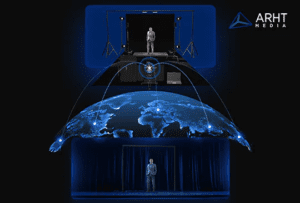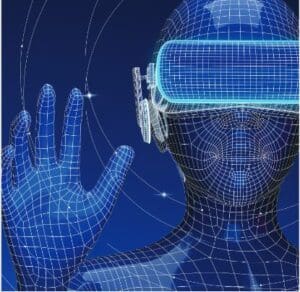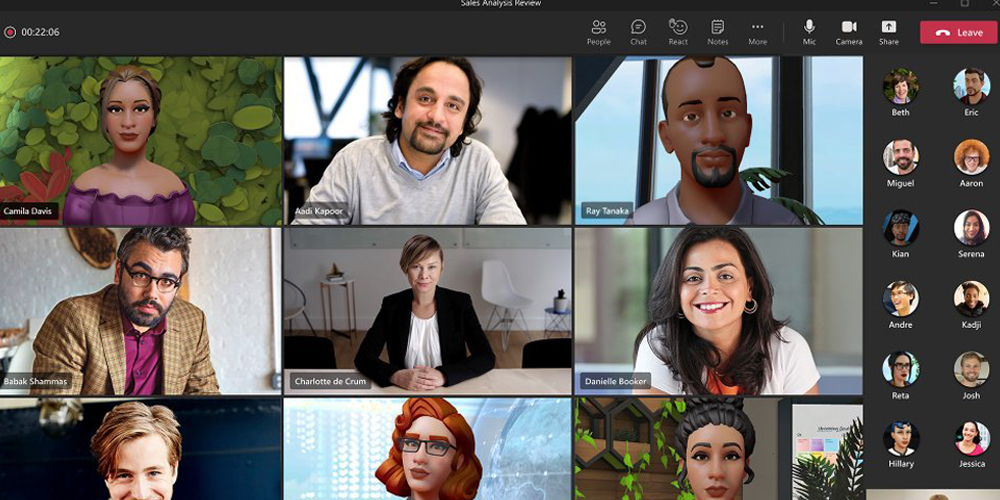For the last 18 months, the entire world has mostly lived on videoconferencing platforms as the COVID-19 pandemic forced organizations to adopt a remote work strategy that leaned heavily on services like Zoom, Microsoft Teams, Webex, and others.
The cloud-based videoconferencing and collaboration services were relatively easy to deploy and scale across an entire organization, which helped many businesses stave off the negative effects of the pandemic and social distancing guidelines while continuing their work.
What set in quickly, however, was a growing weariness of those platforms and long, back-to-back meetings confined to a computer monitor.
However, with a general optimism toward the pandemic’s trajectory, companies are now beginning to return to the office in a hybrid approach that will continue to rely heavily on those technologies.
Software providers have innovated quickly over the course of the pandemic in response to their customers’ needs and a rising level of video fatigue by adding new interfaces and video layouts designed to make virtual meetings more engaging.
That includes recent announcements from Microsoft, Cisco and Meta (formerly Facebook) that integrate a virtual world into widely-used collaboration platforms.
Software giants pushing the VR meeting envelope
These soon-to-be-released offerings center around what is largely referred to as the “metaverse,” a virtual world in which organizations can meet, collaborate and just hang out via customized avatars.
Cisco calls its solution the Webex Hologram. A new service that combines the Webex platform with immersive, 3D holograms; it leverages augmented reality headsets to close the gaps between virtual and in-person collaboration, thus providing real-time photorealistic holographic experiences to improve meetings.

The Webex Hologram leverages augmented reality headsets to close the gap between virtual and in-person collaboration.
Cisco says users of Webex Hologram can also share physical and digital content. For example, an auto manufacturer can use the platform to interact with a physical prototype of a vehicle to examine and provide feedback on the design. Renderings and other digital content can also be shared on the platform.
Microsoft, meanwhile, announced Mesh for Microsoft Teams, a new solution that integrates the mixed-reality capabilities of Microsoft Mesh with its collaboration platform.
The company bills it as an expansion of its video fatigue solutions like Together Mode and Presenter Mode, but in the metaverse via mixed-reality headsets.
According to Microsoft, Mesh for Teams presents a “gateway to the metaverse – a persistent digital world that is inhabited by digital twins of people, places and things.”
“Think of the metaverse as a new version – or a new vision – of the internet, one where people gather to communicate, collaborate and share with personal virtual presence on any device,” the company said in a news release.
To start using Mesh for Teams, users will only need to join a standard Teams meeting as a customized avatar of themselves instead of a static picture or on video. Organizations can also build immersive spaces – metaverses – within Teams, the company says.
Users can then take their avatars into these spaces to “mix and mingle, collaborate on projects and experience those serendipitous encounters that spark innovation.”
Related: Cisco Announces AR Collaboration Platform, Devices, AI Features at WebexOne
Meta, which recently changed its name from Facebook, also recently announced Horizon Workrooms, a virtual reality collaboration experience that brings people together to work in the same virtual room.
According to the company, via an Occulus Quest 2 headset, the solution features mixed-reality desk and keyboard tracking, hand tracking, remote desktop streaming, video conferencing integration, spatial audio, and new Occulus avatars.
Virtual reality integrations into platforms that most AV integrators know well would seem to be a value addition to any unified communication and collaboration offering. However, many view the technology as in its infancy, leaving third-party providers like integrators waiting for further developments and a clear business case.
VR meetings still a buzzword … for now
If you have attended a pro AV conference or trade show, you were probably told about the opportunities brewing in the virtual reality or augmented reality space.
That includes InfoComm 2021 and NSCA’s Pivot to Profit events held in September, during which several expert panels discussed virtual reality, including one on emerging technologies.
Harry Aller, chief technical officer of Innovative Lighting, said at Pivot to Profit that there is a lot of money being thrown at VR and AR, citing Workplace Horizons specifically.
“I’m not sure how integrators can truly embrace that yet, but keep an eye on it,” Aller says.
And, at Almo Professional A/V’s E4 Experience in Dallas, hologram technology from ARHT Media was showcased.
It involves the remote individual occupying a studio space with a roughly six-foot-wide green screen. The hologram then appears on a display surface on the far side, blending into the background environment. The person appearing via hologram is able to speak, move and interact with the audience.
According to ARHT Media, its technology is different from the Michael Jackson and Tupac Shakur holograms one has seen during concerts because the content is being delivered live and in real time, with virtually zero latency.
 Thus, integrators could market it as an alternative to business travel, allowing a C-suite executive to make a lasting impression during a conference or event by appearing holographically, rather than as a face on Zoom or Teams. Other applications include higher education and high-end retail—for example, flagship stores.
Thus, integrators could market it as an alternative to business travel, allowing a C-suite executive to make a lasting impression during a conference or event by appearing holographically, rather than as a face on Zoom or Teams. Other applications include higher education and high-end retail—for example, flagship stores.
However, there have not been many viable use cases for virtual reality in conferencing environments up till now. That may change soon as integrators may be able to expand their partnerships with collaboration software providers and offer solutions to augment these software innovations.
However, how integrators can do that is still up in the air, as those software providers have provided little guidance to integration partners on how they can add value to these platforms.
In emails to Commercial Integrator, Microsoft and Cisco spokespeople both said they want feedback from end users first before bringing service providers like integrators into the mix.
John Bailey, senior vice president of technology and innovation at global integration leader and a high-level service provider partner of Microsoft and Cisco, AVI-SP, said the technology is still in its early stages, but customers are growing curious.
“It’s a topic a lot of customers like to talk about,” Bailey says.
The idea of a virtual reality meeting, Bailey says, is largely still a concept. Instead, Bailey says the most currently applicable place for this kind of technology is where VR/AR are already used.
Instead of adding virtual reality to collaboration, current use cases add collaboration to virtual reality use cases.
“So those are things typically where you need visualization, like design, product management, product creation, industrial design or things where we as a team want to look at and evaluate, manipulate or co-design something in a shared space,” Bailey says.
In those use cases, a three-dimensional visualization already exists, and then the avatar concept is added. However, Bailey says some users struggle with the concept.
“Avatar usage for a lot of people feels like a video game,” he says. “It’s hard for them to wrap their head around [it].”
The technology still needs to mature
The concept of an augmented reality environment in which a physical room full of people wearing glasses can see visual representations of remote participants in empty chairs is exciting, but it largely hasn’t come to fruition.
 According to Bailey, the more viable use cases have been in the educational settings and the medical field as well as other industries that require hands-on experiences and tutoring.
According to Bailey, the more viable use cases have been in the educational settings and the medical field as well as other industries that require hands-on experiences and tutoring.
For example, a surgeon looking at the operating table or a technician looking at parts of a machine through special glasses or goggles can show remote participants what they are looking at.
While it might not be practical for some business environments to have a room full of people wearing goggles just to see representations of remote colleagues in the room, there is an undeniable cutting-edge appeal to the technology, Bailey says.
“It just looks so amazing that somebody can virtually be there without being there,” Bailey says. “I think it gets people pretty excited.”
The demand is there, but the technology still has to mature enough for the widespread adoption many predict. First and foremost, VR glasses need to be less intrusive and easier to wear, Bailey says.
But like the software giants releasing this technology, integrators should listen to their customers that use these solutions to find their place in this conceptual virtual reality.
“We will figure out where it fits and how it’s going to be most valuable for customers, along with customers helping us do that,” Bailey says.










